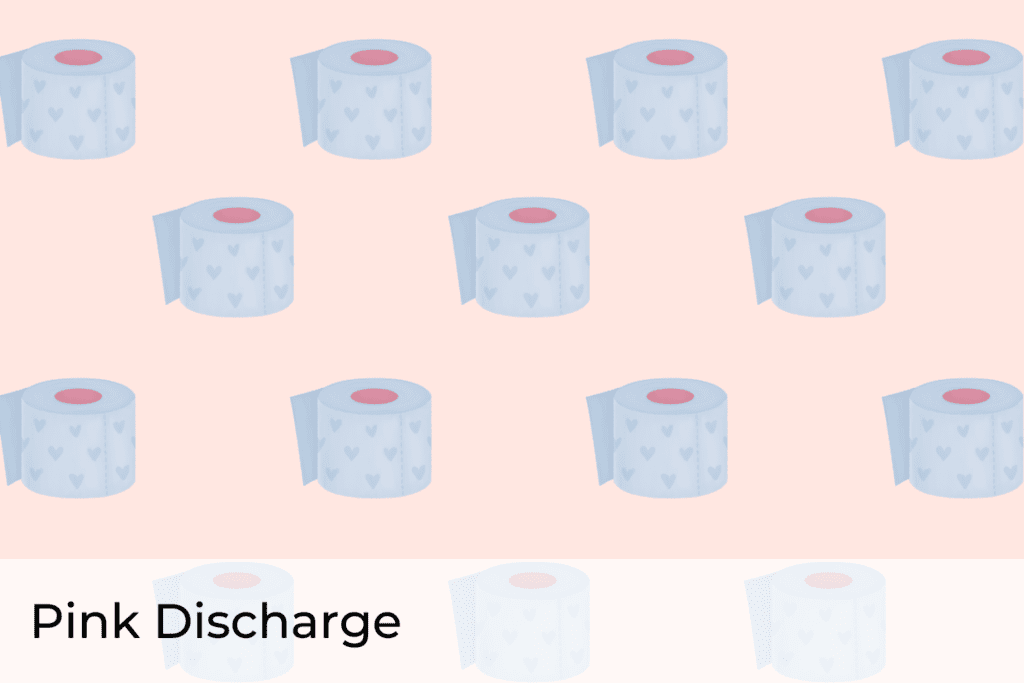
It’s a common belief that getting your period isn’t the most pleasant of experiences, but what if I told you that even when not on their period, the female reproductive system releases another type of fluid from the vagina? This mucus is called vaginal discharge. In most cases, vaginal discharge is a completely normal part of reproductive health. Keeping track of the color and other physical characteristics of your discharge can be helpful to identify when you might be experiencing vaginal infections, starting your menstrual cycle, or it could be a sign of more serious conditions, such as cervical cancer.
One such type is pink discharge. Pink discharge can be caused by a variety of different circumstances, ranging from normal period bleeding to a hormonal imbalance. Regardless, it is always a good idea to monitor and track when you are experiencing pink discharge on a health-tracking app such as CareClinic. Keeping a record can help your doctor come to a diagnosis if you are experiencing abnormal discharge and help get you back to feeling better than ever! [1][2][3][4]
Understanding the Menstrual Cycle

The 4 Phases of the Menstrual Cycle:
The Menses Phases
This is arguably the most well-known phase of the menstrual cycle. It is in this phase that you experience what is commonly referred to as a period. During your period, the lining of the uterus sheds through the vagina if a pregnancy has not occurred. This bleeding can last generally from 3 to 5 days, although this can, once again, vary from person to person.
The Follicular Phase
Following your period, the lining of your uterus once again begins to thicken. Additionally, as your hormone levels change – including your testosterone and estrogen levels – certain signals are sent to the ovaries, essentially telling them to mature an egg. This happens in the last 4 days of the follicular phase. Overall, these processes occur over days 6 to 14.
Ovulation
It is during ovulation that a female is most likely to get pregnant. This is because, during ovulation, the mature egg is released from the ovary to make its way to the uterus. This happens roughly halfway through your cycle, so at about day 14 in a 28-day cycle.
The Luteal Phase
The luteal phase closes off the menstrual cycle – days 15 to 28 – with the traveling of the egg through the fallopian tubes and into the uterus. The uterine lining prepares itself for fertilization and subsequent pregnancy. However, if this does not occur, the uterine lining sheds away. Your period will once again begin, restarting the cycle over again.[5][6][7]
What is Vaginal Discharge?
Now that we’ve established a basic understanding of the female reproductive system, we can get into some of the lesser-known topics, such as the presence of vaginal discharge. Essentially, this discharge is a mixture of fluids and other vaginal secretions. This mixture might include clear cervical fluid, arousal fluids, and cells that are constantly shed and pass through your vagina. In fact, vaginal discharge plays a large role in keeping your tissues healthy.
It provides lubrication, can help with egg fertilization, and plays a major role in protecting against infections. Once again, it is important to note that some people might experience more, while others experience less vaginal discharge. Additionally, the type of discharge you may be experiencing tends to vary depending on where you are in your menstrual cycle and on your health as a whole.
Normal Vaginal Discharge
The type of discharge you are most used to seeing is likely your normal physiological discharge. This type of discharge is generally white or clear and appears thick and sticky in consistency. The presence of this type of discharge is relatively consistent across most of your menstrual period.
How your Discharge Changes Across your Cycle
Discharge During Menstruation
During your period, you most likely will not notice any vaginal discharge. This is pretty self-explanatory: all the fluids and cells that normally expel through discharge mix in with your menstrual blood instead. Towards the end of your period, you may experience small amounts of discharge, sometimes with traces of leftover brown blood visible as well. This is completely normal and is nothing to be worried about!
Discharge in the Follicular Stage
Leading up to your ovulation date, your cervix actually produces more cervical fluid. Thus, your discharge may appear thicker, creamy, and white or cloudy in colour. The reason for this is simply that your body isn’t ready for pregnancy yet, and so naturally, your vaginal mucus is trying to prevent fertilization.
Discharge while you’re ovulating
However, ovulation is a completely different story. During ovulation, your vagina produces the largest amount of discharge that is clear, wet, and stretchy. The watery nature of this discharge intends to helps fertilization occur and counters the natural acidity of the vagina.
Discharge and the Luteal Phase
Luteal discharge is a bit of a wild card. Discharge during this time of your cycle might be sticky or dry. You might not even experience any discharge at all! The lack of discharge is generally a physiological method to stop sperm from entering the reproductive tract. This is because your body isn’t ready for pregnancy at this time. Contrarily, the production of thick discharge is simply a protection mechanism against possible infection, especially if an egg has been implanted following fertilization.[8][9][10]
Identifying Abnormal Discharge
Your hormones, life events, and health status can play a significant role in the type and amount of discharge you experience. As such, it can be difficult to identify what might be considered an abnormal discharge. Overall, the best advice I could give you is to look out for textures, smells and colors you haven’t seen before. The presence of these can be indicators that something else is going on and are a sign you should consider going to see a doctor. For now, here is a color guide list of discharge you might experience that is different from the typical clear-to-cream appearances we’ve discussed so far.
Red/Brown Discharge
This type of discharge is most often found during your period when old (or new) blood mixes in with your discharge. At any other point in your cycle, this type of discharge could be a sign of infections or other underlying health conditions.
Yellow to Green Discharge

Pale yellow discharge is generally considered normal and is generally classified under the ‘cream’ color category. When this yellow starts to become more vibrant and may even appear green – that’s when you might decide to take a closer look. Yellow-green discharge is generally indicative of an infection, such as a yeast infection. However, it can also be the result of the food you have eaten lately. It’s important to monitor when you see this color discharge and how often in order to decide if there really is a need for concern5.
When it comes to diet, it can be hard to remember what you eat and when. It can be even harder when you’re looking for a pattern between your symptoms and diet. Fortunately, the CareClinic app offers a built-in nutrition tracker. The tracker includes the type of food you’re eating, how much of it, as well as the time you are eating. Once you notice abnormal discharge, starting to track your diet and seeing if you can recognize any patterns can be a great way for you to determine if the color is due to the foods you’re eating or something else!
Gray Discharge
Gray discharge is definitely a possibility and is a sign of infection. Make sure to talk to a healthcare professional as soon as possible if you notice gray color discharge. Most often, gray discharge indicates an overgrowth of natural vaginal bacteria5.[11]
What is Pink Discharge?
One color of discharge that we haven’t really talked about yet is pink discharge. If you’re wondering what pink discharge means, it’s exactly what it sounds like! Pink discharge is essentially pink vaginal fluid. So, with this in mind, does pink discharge indicate a serious health issue?
This is a tricky one because light pink discharge can point to a variety of different things. So today, I’m here to help break down pink discharge and its causes. Hopefully, this helps you better understand why you might be experiencing pink discharge.
Common Causes of Pink Discharge
Some common conditions that cause pink discharge are:
Light Bleeding: The vagina can bleed fairly easily. Sometimes, that light bleeding can mix in with normal discharge and make it appear more of a pink hue. In this case, light pink discharge really is no big deal, but the context is important in this scenario. Make sure to note down when you had a pelvic exam, the last time you had sex, if you’re at the beginning of your period, etc. In this way, you’ll be able to easily identify unexpected pink vaginal discharge not related to an external event.
Implantation Bleeding and Breakthrough Bleeding: At the very beginning of pregnancy, about 30% of people experience implantation bleeding. This implantation bleeding sometimes looks like a pink discharge. On the other hand, if you’re on hormonal birth control or have recently taken an emergency contraceptive pill, pinkish discharge, or bleeding at any point in your cycle other than your period, can sometimes be a side effect. This type of bleeding when not on your period is breakthrough bleeding.
Irregular Menstrual Cycles and Irregular Periods: Many women and people who get periods suffer from irregular bleeding/irregular menstruation for a variety of reasons. If you have polycystic ovarian syndrome (PCOS) or are perimenopausal, you might experience pink discharge instead of your period or at other points during your menstrual cycle. This is often due to the presence of ovarian cysts and changes in hormone levels.
Hormone Imbalance: Hormones are the key regulators of the menstrual cycle. An abrupt change in your testosterone and estrogen levels often leaves your reproductive system in confusion. This can cause spotting throughout your menstrual cycle. This spotting can sometimes occur as a pink, dark red, or brown spotting. It is generally associated with other symptoms such as hot flashes or mood swings.
Other Potential Serious Causes of Pink Discharge
Ectopic Pregnancy: Ectopic pregnancy occurs when the fertilized egg implants outside of the uterus. This could be in other parts of reproductive anatomy, including the fallopian tubes. An ectopic pregnancy occurs in about 2% of pregnancies and is a potentially life-threatening complication. In fact, without proper treatment and care, an ectopic pregnancy can lead to fallopian tube rupture. Pink spotting or light pink discharge, combined with severe pain in the abdomen, shoulder pain, and light-headedness, can be indicative of an ectopic pregnancy.
Sexually Transmitted Infections (STIs): An STI is an infection in the uterus, cervix, or vagina. There are many different possible types of STIs, including chlamydia, gonorrhea, and trichomoniasis. The presence of an STI is often distinguishable by abnormally colored discharge. Specifically, brown, green, and you guessed it, pink discharge. Other symptoms of an STI include painful or a burning sensations during urination, fishy or foul-smelling discharge, and abdominal and pelvic pain.
Uterine Fibroids: Uterine fibroids are benign (non-cancerous) growths that occur within the uterus. These growths appear in about 25% of women and can be asymptomatic. In the case that there are other symptoms of a fibroid, they may include abnormal vaginal bleeding (pink discharge or pink spotting) along with lower back pain, pelvic pressure, difficulties with urination, and reproductive dysfunction.
Miscarriage: Approximately 26% of all pregnancies end in a spontaneous loss in early pregnancy. This is known as a miscarriage. Most miscarriages occur in the first trimester and are due to genetic abnormalities that halt fetal development. Some other symptoms of miscarriage include light pink vaginal discharge or pink spotting, along with cramping and sharp pain in the abdomen 6.
Cervical Cancer: Cervical cancer is the fourth most common female malignancy world, with almost half a million women being diagnosed each year. High-risk variants of the human papillomavirus are the cause of cervical cancer. Although not common, abnormal bleeding, light vaginal bleeding, or pinkish discharge can all be symptoms of cervical cancer. Other symptoms include pain during sexual intercourse and unexpected weight loss.
Help Discover the Cause of Your Pink Discharge Using CareClinic

The CareClinic app offers an all-in-one, easy-to-use symptoms tracker. This tracker is especially useful if you’re trying to uncover the cause of your pink discharge. By tracking your other symptoms – such as severe one-sided pain, abdominal pain, cramping, and headaches – you’re much better able to notice trends in your discharge versus your other symptoms. Not only will you stay informed about your health, but by providing your doctor with your tracker, you can help your healthcare provider stay informed too. This can lead to faster diagnoses and treatment in the case of a medical situation.[12][13]
How to Treat Pink Vaginal Discharge
When it comes to your doctor might only recommend treatment if the discharge boils down to a specific cause. So, if you’re ever wondering how to treat your pink discharge, you treat the underlying cause!
In the case of hormonal contraception- such as oral birth control, hormone replacement therapy, ovarian cysts, fibroids, or menopause, there isn’t really much you can do to prevent light pink discharge from occurring. Moreover, pink discharge in these cases is often not a cause of concern.
However, if you do experience abnormal pink discharge, then your doctor will likely address whatever it is that is causing your symptoms. Some common treatments for these causes include:
- Surgical removal of fibroids and cysts that are causing additional symptoms other than the discharge
- Medication/surgical procedures for ectopic pregnancy, or in some cases, miscarriage
- Medication for STIs or other pelvic inflammatory disease
- Chemotherapy, radiation, or surgery for cervical cancer [14]
How CareClinic Can Help
If you notice pink discharge, it is always a good idea to consider the context of when you are getting it, if there are any patterns, and if it might be considered abnormal. This can help you understand when it’s time for you to seek medical attention and see a doctor. This is especially important since pink discharge can be a sign of a more serious health condition or medical emergency.
Luckily, the CareClinic app allows you to track your period-related symptoms easily using the built-in period tracker. This tracker is available under the factors check-in tab. The period tracker not only offers you a place to record your customized factors but also helps you notice correlations between symptoms and other changes in your life using the charts and reports feature.
By comparing when you notice pink discharge to other aspects such as other symptoms, other medications you are taking and your diet, it becomes much easier to distinguish when your discharge shifts from normal to abnormal. Overall, using the CareClinic app can help you decide when it’s time to seek medical care and get you feeling back to yourself, faster!
References
- Cleveland Clinic. (2022, September 12). Menstrual Cycle. Health Library. Retrieved from: https://my.clevelandclinic.org/health/articles/10132-menstrual-cycle
- Mayo Clinic. (2021, June 22). Vaginal Discharge. Retrieved from: https://www.mayoclinic.org/symptoms/vaginal-discharge/basics/definition/sym-20050825
- Rao, V. L., & Mahmood, T. (2020). Vaginal discharge. Obstetrics, Gynaecology & Reproductive Medicine, 30(1), 11–18. https://doi.org/10.1016/j.ogrm.2019.10.004
- Daye. (2021, May 27). How Your Vaginal Discharge Changes During Your Cycle. Vitals By Daye. Retrieved from: https://yourdaye.com/vitals/womens-health/vaginal-discharge-during-menstrual-cycle-normal/
- Aswell, S., & Santos-Longhurst, A. (2023, February 23). The Ultimate Vaginal Discharge Color Guide. Retrieved from: https://www.healthline.com/health/vaginal-discharge-color-guide
- Malka, T. (2022, May 31). Pink Discharge: Causes and What to Expect. Retrieved from: https://khealth.com/learn/vaginal-discharge/pink/
- Murray, H. (2005). Diagnosis and treatment of ectopic pregnancy. Canadian Medical Association Journal, 173(8), 905–912. https://doi.org/10.1503/cmaj.050222
- Stewart, E. A. (2001). Uterine fibroids. The Lancet, 357(9252), 293–298. https://doi.org/10.1016/s0140-6736(00)03622-9
- Cohen, P. A., Jhingran, A., Oaknin, A., & Denny, L. (2019). Cervical cancer. The Lancet, 393(10167), 169–182. https://doi.org/10.1016/s0140-6736(18)32470-x
References Some women also get UTIs right before their period starts. Your body goes through hormone changes that can make you more likely to get infections during this time. If you notice burning when you pee along with your other period symptoms, a uti before period might be what’s happening.
- “Vaginal Discharge Color: What’s Normal and What Isn’t”. https://health.clevelandclinic.org/vaginal-discharge-mean
- “Pink vaginal discharge: 7 causes and how to prevent it | HealthShots”. https://www.healthshots.com/intimate-health/feminine-hygiene/pink-vaginal-discharge/
- “Pink Discharge: 11 common causes and when to see a GP”. https://www.womenshealthmag.com/uk/health/female-health/a29639568/pink-discharge/
- “Why is My Discharge Pink? | LifeMD”. https://lifemd.com/learn/why-is-my-discharge-light-pink
- “Physiology, Menstrual Cycle – StatPearls – NCBI Bookshelf”. https://www.ncbi.nlm.nih.gov/books/NBK500020/
- “Follicular Phase Of Menstrual Cycle: Hormone Levels & Length”. https://my.clevelandclinic.org/health/body/23953-follicular-phase
- “Normal Menstrual Cycle | UCSF Center for Reproductive Health”. https://crh.ucsf.edu/about-fertility/normal-menstrual-cycle
- “Vaginal discharge”. https://en.wikipedia.org/wiki/Vaginal_discharge
- “A Beginner’s Guide to Understanding Your Menstrual Cycle – Verily”. https://verilymag.com/2014/06/understanding-your-menstrual-cycle
- “Hormonal health – clues made clear | Jean Hailes”. https://www.jeanhailes.org.au/news/hormonal-health-clues-made-clear
- “SMSNA – What Might the Color of Your Vaginal Discharge Mean About Your Health?”. https://www.smsna.org/patients/did-you-know/what-might-the-color-of-your-vaginal-discharge-mean-about-your-health/
- “Pink Discharge: Know Causes and How to Treat It? – Sirona”. https://blog.thesirona.com/intimate-talk/pink-discharge-before-period/
- “Pink Discharge: 9 Causes & What It Means – Tua Saúde”. https://www.tuasaude.com/en/pink-discharge/
- “Pink Discharge: Causes and Treatments”. https://www.health.com/pink-discharge-8706345


